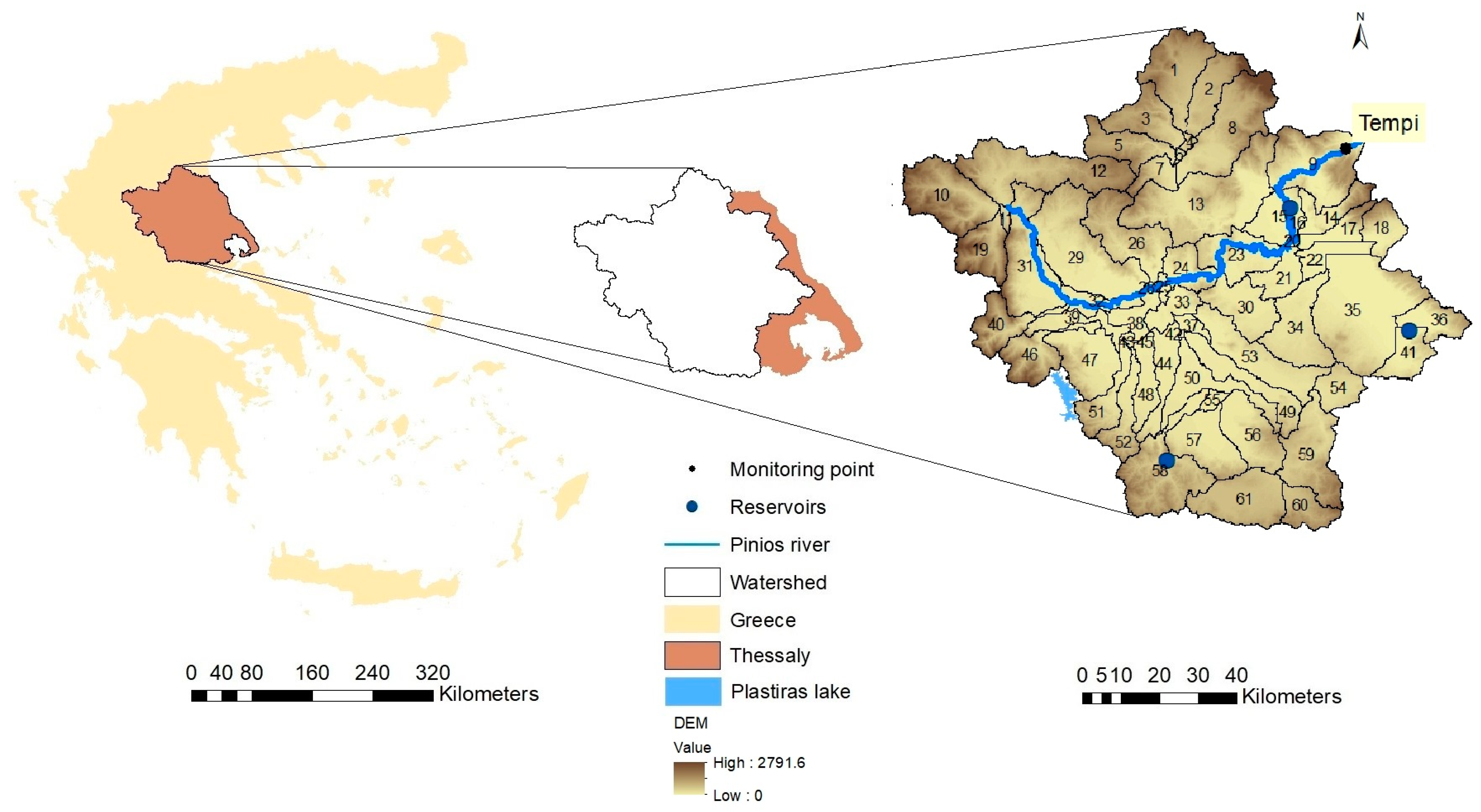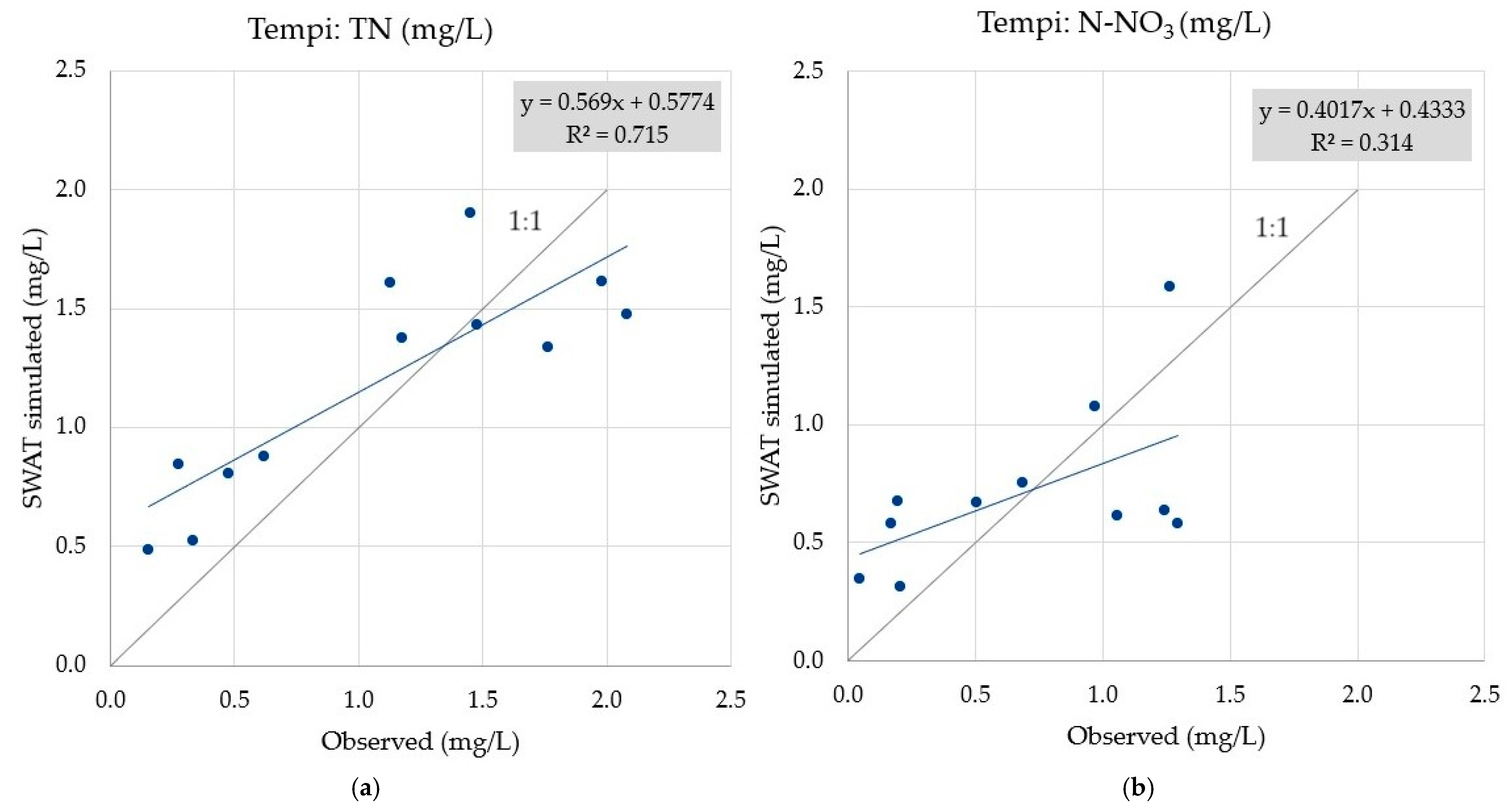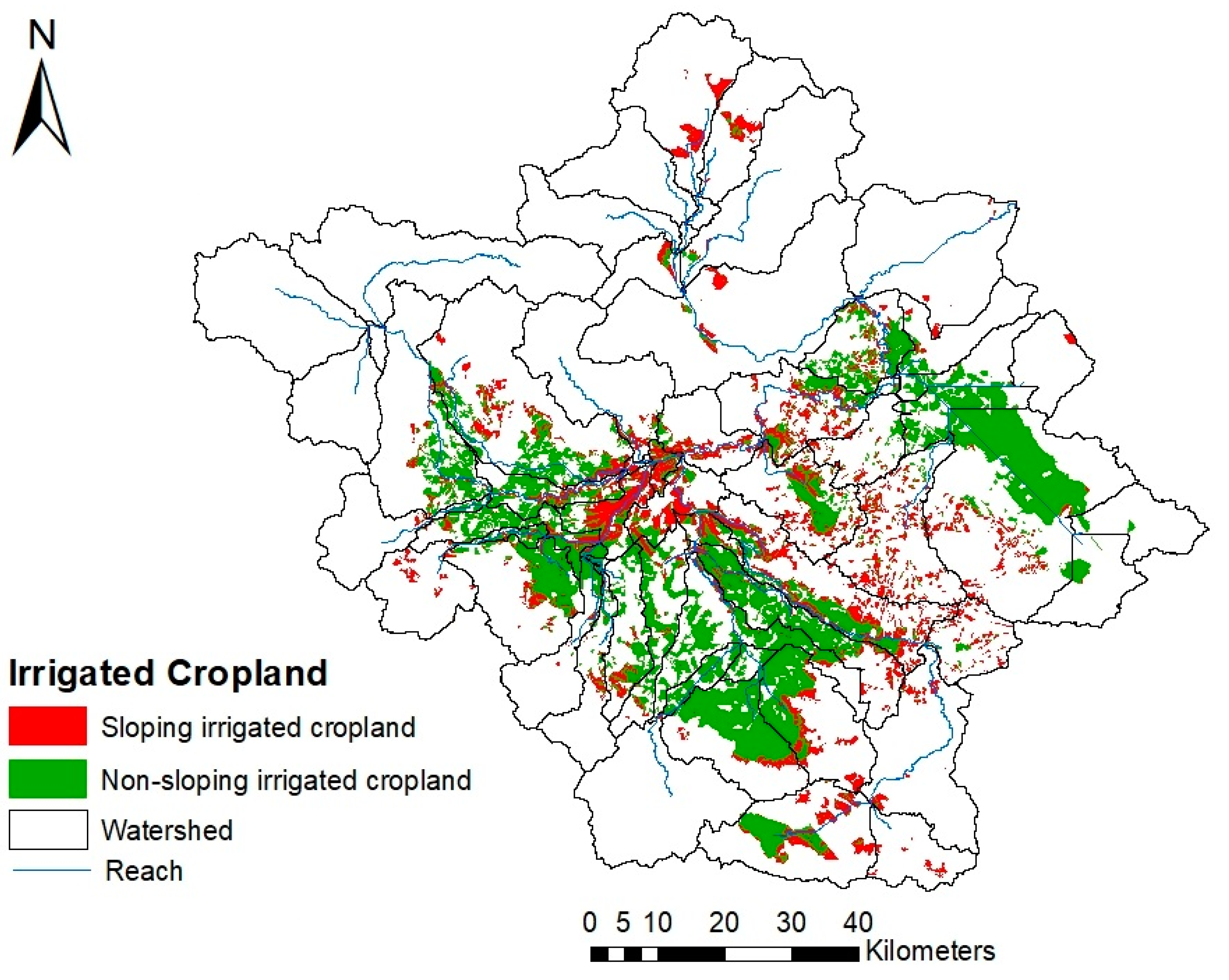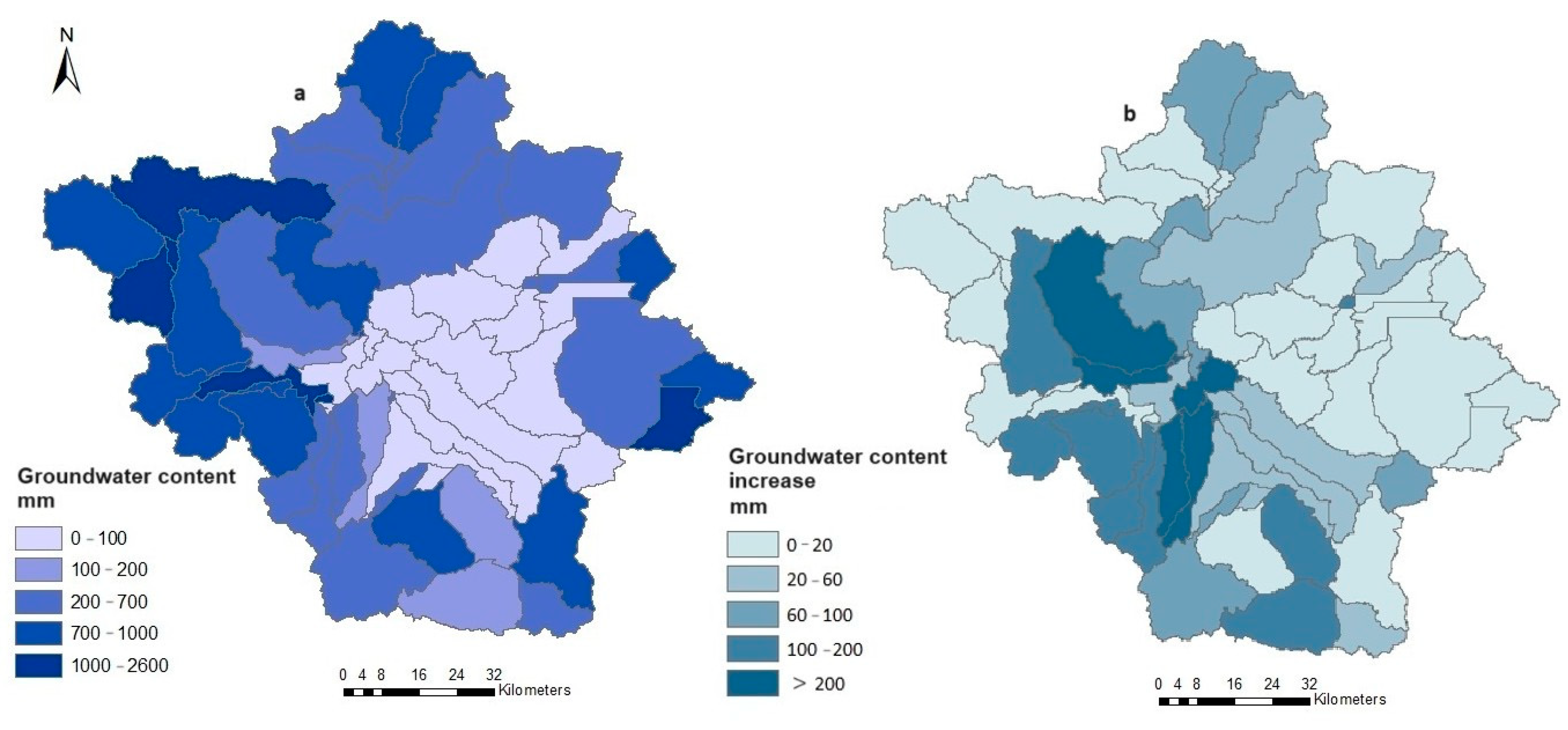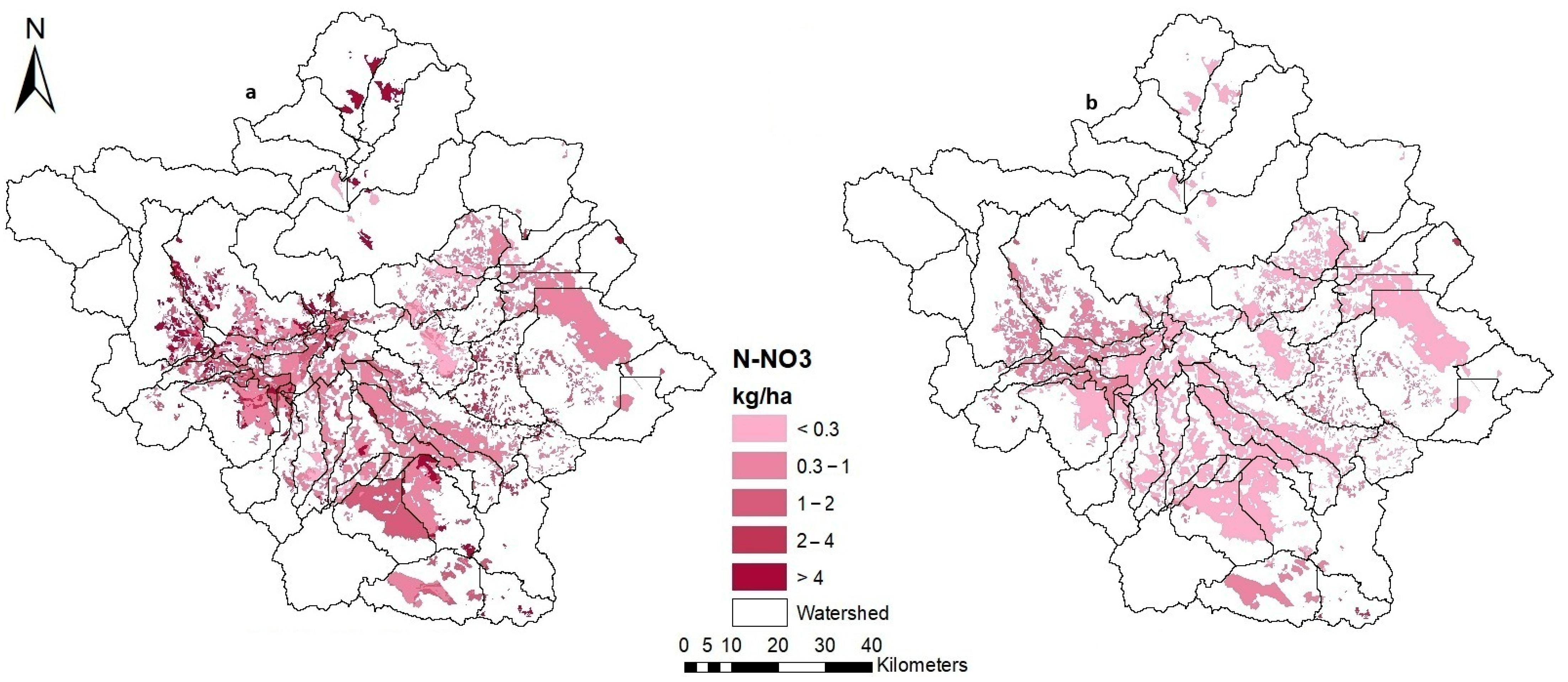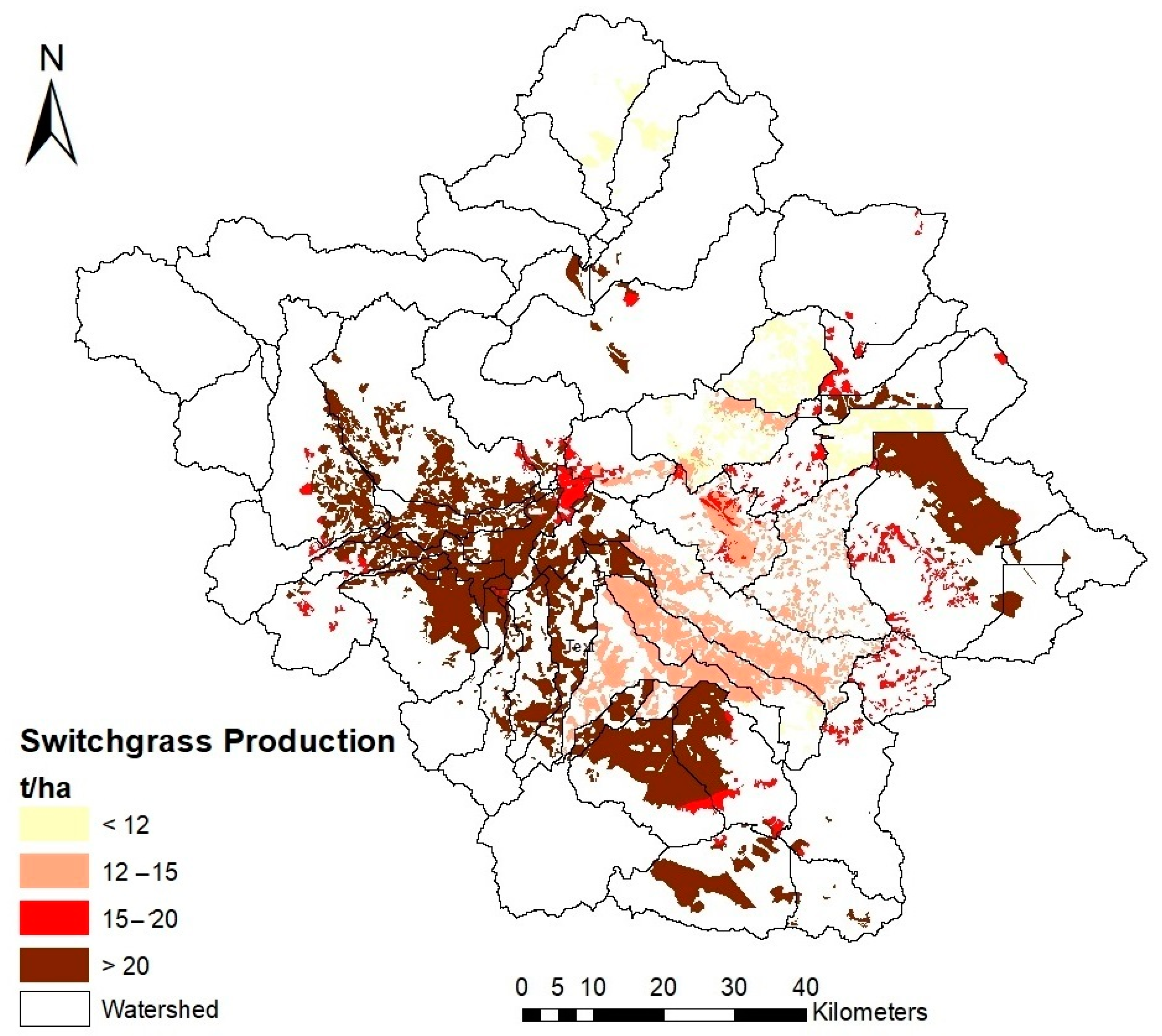1. Introduction
Water degradation is often caused by the intensification of agricultural activities. Especially around the rural landscape of the Mediterranean region, agriculture has led to the overexploitation of water reserves for irrigation and to a decline in water quality due to non-point source pollutants like fertilizers and pesticide residues entering water bodies [
1,
2,
3,
4,
5]. While intensive agriculture is crucial for food, feed, and fiber production, achieving a balance between water quality and quantity is a challenge. Therefore, appropriate management practices are required to accomplish these conflicting objectives and meet the objective of a good ecological status required by the Water Framework Directive (WFD) (Directive 2000/60/EC, 2000) and the Nitrates Directive (Directive 91/676/EEC) [
6].
In addition, agriculture is being promoted globally as a significant method for sustainable energy production through the cultivation of bioenergy crops for renewable energy. The European Union (EU) has implemented measures to advance biofuels through the Renewable Energy Directive (Directive 2018/2001), which is part of the European Green Deal aiming for a climate-neutral EU by 2050. Biomass and biofuels are seen as promising energy sources within the current energy crisis in the EU, as they can be produced domestically, thereby reducing the dependence on energy imports. The need to increase bioenergy production in Greece has been recognized in recent decades [
7]. Efforts to increase the combined heat and power production from biomass and to replace portions of gasoline and diesel with liquid biofuel have been reported from more than a decade [
8]. However, the national use of renewable energy sources remains low. As an EU member state, Greece must comply with the European Directive, which, for example, mandates that biofuels should contribute to >10% of the total transport energy consumption by 2030 [
9].
Besides energy targets, bioenergy production can, however, have positive environmental impacts when it comes from bioenergy crops that are incorporated within existing resource-demanding cropping systems. Specifically, perennial bioenergy crops are considered a viable option since they have the capacity to substantially reduce nitrate losses and subsequently reduce non-point source pollution [
10]. In addition, bioenergy crops like sunflower and sorghum require less irrigation water than most irrigated crops, enhancing groundwater conservation [
11]. In particular, the perennial bioenergy crop switchgrass, introduced from the US and characterized as low-input, is expected to exhibit similar behavior. Nevertheless, producing bioenergy requires extensive agricultural areas, often leading to significant land use changes. Therefore, it is essential to assess a bioenergy crop’s socio-economic and environmental footprint before selecting it for regional planning. In Greece, no such plan has yet been proposed for any agricultural region to ensure the continuous, uninterrupted production of bioenergy products.
The Thessaly plain, located in the center of Greece, represents the most important agricultural producer in the country. The largest river basin in the area is Pinios river basin (PRB), covering roughly 11,000 km
2. It is characterized by a Mediterranean climate, fertile soils, and a mild topography and is considered ideal for a variety of crop cultivation. These characteristics have caused the intensification of irrigated agriculture in the region, with water quantity and quality implications [
5,
12]. This region is included in the list of areas characterized as nitrate-vulnerable zones, with a negative water balance [
13].
For the assessment of land use changes at the river basin scale, including changes in cropping patterns and their effects on water resources, advanced hydrological models that can provide time-efficient water quantity and quality predictions are widely utilized. Specifically, the process-based Soil and Water Assessment Tool (SWAT) model has been used worldwide in a wide range of studies, among which one can find a few involving bioenergy crop simulations [
14,
15,
16]. Of substantial interest to the present paper are SWAT studies on bioenergy crops that have highlighted significant nitrate loss reductions and considerable biomass accumulation for potential energy production, even when they are grown in low-productivity areas [
17,
18]. Moreover, Gassman et al. [
19] found that the realistic, limited inclusion of bioenergy crops within agricultural systems can result in a considerable reduction in the loss of nitrates from land to water.
Recent publications on SWAT from Greece that can be considered relevant to the present study are only studies that have investigated the impacts of water management practices on the hydrological status of rivers or the water budgets of agricultural areas, as well as studies that have dealt with land use changes and their effects on pollution loads [
20,
21,
22]. To the best of our knowledge, no studies dealing with bioenergy crop simulation in Greece exist in the literature.
The present study aims to build a dynamic SWAT hydrological and management model of the intensively managed PRB that considers climate, land use, and agricultural practices to estimate the crop yields and evaluate the resulting quantity and quality of the surface water and groundwater. Using this model, this study is the first to attempt a realistic simulation of the switchgrass growth cycle in Greece and execute rough scenarios of its implementation across large agricultural areas in order to explore the potential upper levels of water improvements and biomass production at the river basin scale.
4. Discussion
The PRB SWAT model developed in this study realistically simulated the hydrological and N cycle processes occurring at the river basin scale. Even though the N model predictions were only compared with river observations made at the basin’s outlet, the available data allowed for an adequate evaluation by the model at large time steps and for the entire basin. For the acceptance of the model predictions at nested sites of the basin, we had to rely on robust spatial parameterization of the model with respect to the land use, soil, and management.
This was the case for the crop yields and switchgrass biomass production in particular, as well as for the impact of switchgrass on water quality and quantity, for which it was essential to rely on other research studies with which to compare our model’s predictions. The reduction in surface runoff caused by the switchgrass implementation was the combined effect of (a) the more dense land coverage that characterizes most perennial crops compared to that of annual crops, resulting in reductions in surface runoff [
56]; (b) the reduced amount of water that switchgrass received as irrigation, which also resulted in the production of less water capable of becoming runoff; and (c) the slightly increased ET, leaving a reduced amount of water to be lost via runoff [
57].
As has been stated, switchgrass received notably less irrigation water compared to that received by the existing irrigated crops in the PRB, which led to the assumption that its adoption could increase groundwater reserves. Indeed, apart from the reduced direct abstraction of water, in the majority of the HRUs, switchgrass was also able to reduce the surface runoff and increase the soil’s water content and percolation, the water that moves below the root zone over time [
58]. While this was a fair observation at the entire basin level, there were certain HRUs where the opposite was observed due to less water being applied to the topsoil via irrigation. Overall, despite the fact that the areas that were available for the installation of switchgrass covered small percentages of the entire basin (19% of the basin represented the total irrigated cropland, 5.8% was the sloping irrigated cropland, and 13.2% was the non-sloping irrigated cropland), the individual effects in the subbasins were anything but trivial, as they proved to have the potential to improve the water availability considerably because of the reduced abstractions.
Regarding the total irrigation water used in the PRB, as expected, the effect of the fourth scenario (switchgrass in non-sloping irrigated cropland) was greater than the effect of the third scenario (sloping irrigated cropland), and this difference was attributed to the significantly greater area of non-sloping irrigated land that was available for the installation of switchgrass in the fourth scenario. This resulted in the replacement of more crops with greater irrigation water needs. Based on all of these results concerning the hydrology of the area in all of the developed scenarios, it can be concluded that the perennial crop could be effective in alleviating the high water abstraction from the shallow aquifers of the PRB and in this manner enhancing their water balance.
The agricultural use of N fertilizers has been a major contributor to the N export into the water from agricultural areas. Specifically, in PRB, which is highly vulnerable to N-NO
3 pollution, N-NO
3 reduction was considered to be of great importance. The trend in the N loss reduction was correlated with the N transported in dissolved form via runoff (mainly N-NO
3). In general, the decrease in N-NO
3 loading was mainly because switchgrass required a lower N fertilizer input in comparison to that for the baseline crops. The model simulations indicated that the adoption of the biofuel crop could reduce the N losses compared to those in the current cropping systems used in PRB, as observed in other studies as well [
17,
19,
59,
60]. The level of the reduction varied between scenarios, with the areal extent of the deployment of the bioenergy crop being the key factor for the greatest reduction being caused by the second scenario (with all irrigated crops replaced with switchgrass). However, the third and the fourth scenarios had the same overall effect at the basin level, resulting in average N-NO
3 loss rates of 1.37 and 1.38 kg/ha, even though a lower rate was expected in the fourth scenario with switchgrass implemented in double the area compared to that in the third scenario. The almost identical N-NO
3 reduction is obviously attributed to the greatest effect of the perennial crop in sloping areas where an increased reduction in runoff led to a more pronounced N-NO
3 reduction as well. The rather low N-NO
3 percentage reduction of 7% (1.37 and 1.38 from 1.48 kg/ha as shown in
Table 10) was considerable for both scenarios since the conventional crop replacement represented a small percentage of land cover change in the entire basin (5.8% for the sloping irrigated cropland scenario and 13% for the non-sloping irrigated cropland scenario), and additionally, in both scenarios, there were extensive areas of non-irrigated wheat, not replaced by switchgrass, that still contributed greatly to N pollution (wheat HRUs contributed 47% of the total N-NO
3 pollution from the cropland in the first baseline scenario). So, even though the effect was not as significant at the entire basin level as in the irrigated HRUs, if the perennial crop was planned to be installed in the entire sloping cropland (irrigated and non-irrigated), the N-NO
3 could be reduced substantially, probably leading to impressive water quality improvements.
Nitrate pollution in PRB had anthropogenic activities as its main sources, mostly crop cultivation and secondly livestock farming. In groundwater, nitrate pollution is generally caused by the accumulation of nitrates, which in some cases can reach levels that are prohibitive to the use of water for water supply purposes. This means that the magnitude of N-NO
3 leaching is directly or indirectly governed by N fertilization, N crop uptake, and the N lost from the soil that is transported into streams. Additionally, the increased concentration of leaching nitrates can be attributed to the high irrigation rates in these areas [
61,
62]. Thus, the reduced leached N-NO
3 concentrations due to the switchgrass implementation were expected, as the perennial crop could reduce the N-NO
3 leaching from the agricultural lands in our study area significantly due to its lower irrigation and N fertilization needs.
One limitation of SWAT in the simulation of crop growth is its inability to account for crop diseases in specific areas and years that may have led to relatively higher simulated yields in certain years than those reported. Hence, it is always preferred to discuss the simulated average annual yields, and this was the case for the switchgrass biomass production simulated under these scenarios. By calculating the biomass yields in sloping areas only, it could be concluded that some of the highest yields occurred there. Evidently, switchgrass had great potential to grow in these areas. The average biomass production calculated in the sloping land scenario was 18.2 t/ha, and the maximum production observed in a single HRU was 22 t/ha. The areas where inadequate production (of less than 12 t/ha) was observed (
Figure 7) could be related to irrigation water deficits in these areas. In the center of the basin where the main part of the Thessaly plain (lowland areas) is located, there were constant biomass production yields of less than 15 t/ha (
Figure 7). This can be also attributed to the insufficient groundwater content of the aquifers in this subregion due to the lower precipitation levels in this area, which has subsequently led to less percolation and aquifer recharge compared to those in other areas in the western parts of the basin. The deficit irrigation observed further proved that irrigation water was the main limiting parameter for switchgrass crop growth, as was stated by Giannoulis et al. [
63] about this particular subregion of the PRB. It should be also noted that all of the irrigated areas served by reservoirs in this study had no problems with irrigation water shortages. A representative example of the positive role of reservoirs in meeting irrigation water needs in the PRB is the large area irrigated by the Karla reservoir in the most eastern part, where despite low precipitation and groundwater recharge, the switchgrass biomass production reached its maximum values of >20 t/ha/y (
Figure 7).
Concerning the conventional irrigated crops in the PRB, their spatially averaged simulated yield rates per ha of cropland in the last two scenarios, when only part of the irrigated land was replaced with switchgrass, did not practically change from their average (per unit area) simulated yields at the baseline. However, an added benefit that was observed at the very local level under the partial replacement of irrigated conventional crops with switchgrass in the third and fourth scenarios was the increased availability of groundwater due to the reduced overall abstraction. The implementation of switchgrass solely in sloping/non-sloping irrigated areas offered the potential for the production yields of the adjacent conventional crops in non-sloping/sloping areas that were irrigated inadequately before to be improved due to the increased amounts of irrigation applied from groundwater.
5. Conclusions
The purpose of this study was to provide estimates of the effects that switchgrass cultivation could have on the water quantity and quality when implemented in large areas of a Greek agricultural basin using SWAT. The bioenergy crop proved to have great potential to grow in sloping areas and produce sufficient amounts of biomass, even though these areas were expected to have a relatively lower productivity due to their higher susceptibility to soil and nutrient losses. Specifically, the N-NO3 reductions at the basin level varied between 7 and 18% depending on the extent of deployment of the bioenergy crop, while there were individual HRUs with switchgrass installed where these reductions were greater than 80%. Implementing switchgrass on sloping land proved to be very effective in reducing the N-NO3 loads. Furthermore, the cultivation of the bioenergy crop could significantly alleviate the irrigation water abstraction by 10–40% depending on the replaced crops and the areal extent of the bioenergy crop’s installation. As a result, switchgrass increased the groundwater availability at several subbasins; specifically, for groundwater bodies in the most intensively irrigated central part of the basin, this increase was locally even higher than 50%.
Indeed, this study supports the progressive substitution of parts of the cropland containing conventional crops with bioenergy crops, promoting them as an effective restoration measure for water bodies, according to the WFD requirements, that could be also adopted in the next phases of regional WFD management plans. Ongoing research activities such as an economic analysis and the development of an efficient optimization tool could add value to the preliminary results presented in this paper, as they will allow additional criteria to be taken into consideration when selecting the locations for switchgrass implementation. It is believed that this current study on switchgrass simulation using SWAT, along with future directions, constitutes a useful approach to hydrological, water quality, and bioenergy crop simulations that could help decision-makers and water managers incorporate bioenergy crops into their combined efforts towards renewable energy production and water protection.
